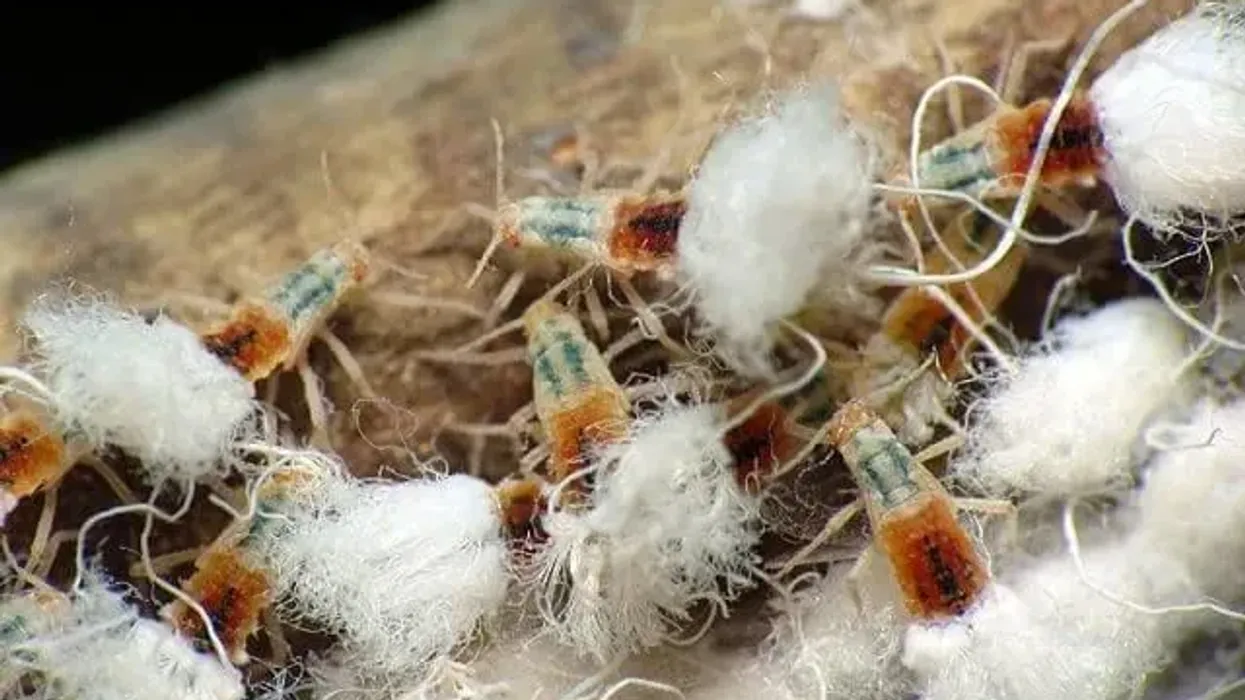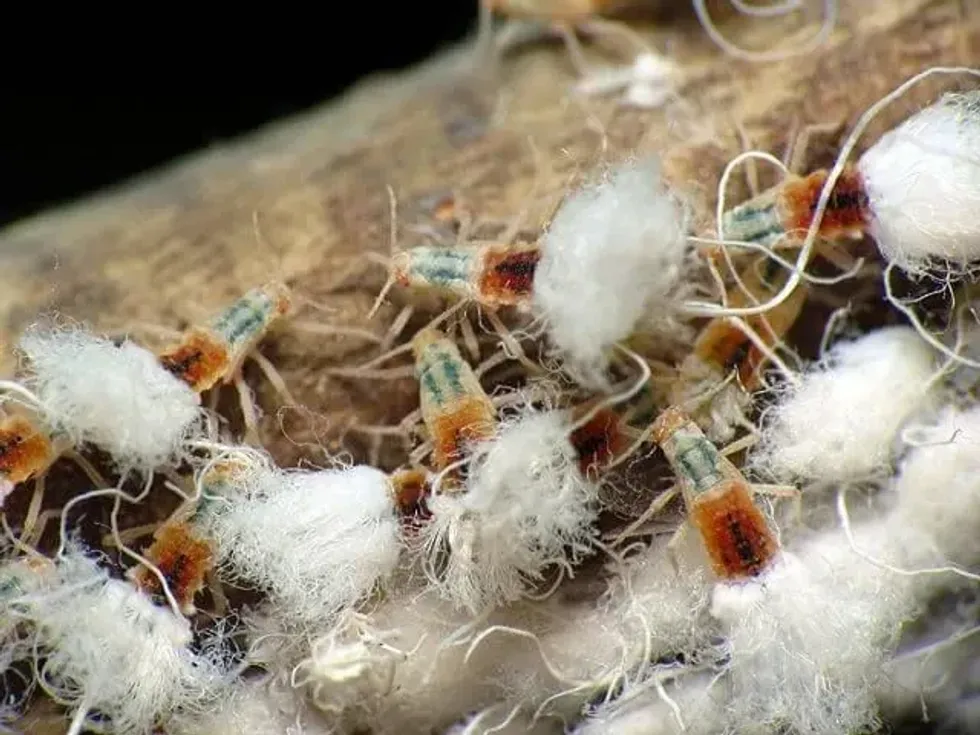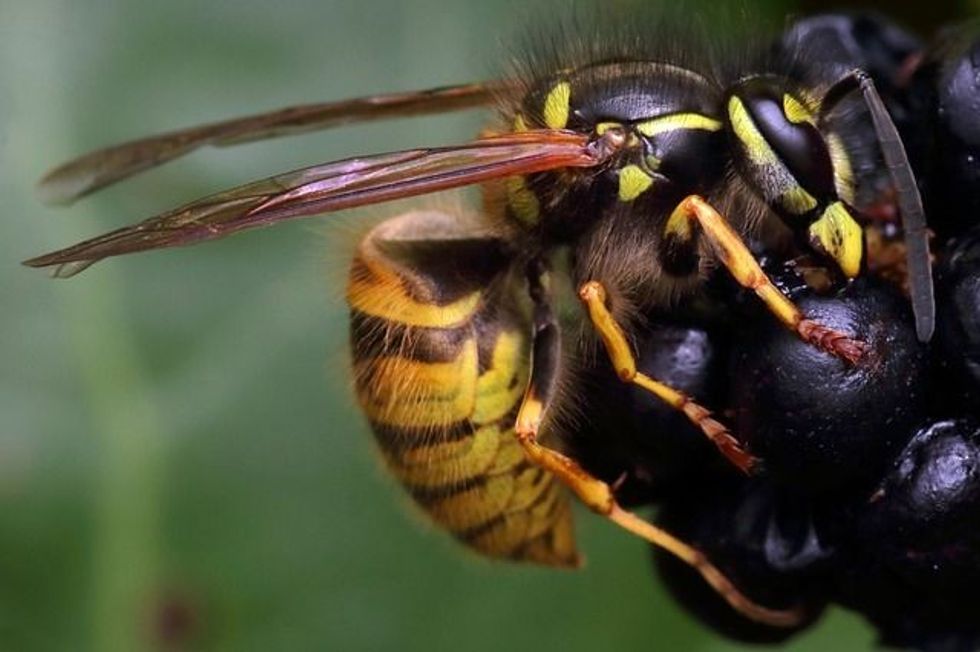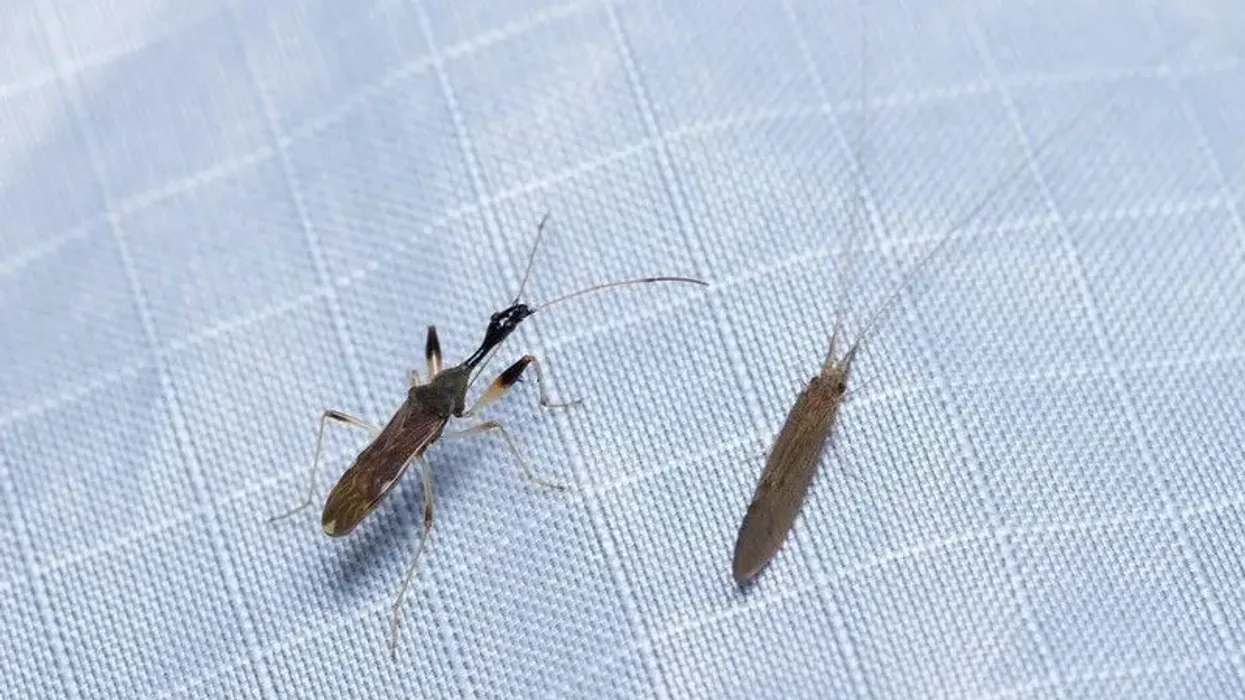The beech aphid (scientific name: Grylloprociphilus imbricator) is a woolly aphid species that is seen in North America, from Maine to Florida. It is known to appear in a dramatic fashion.
The coloration of the aphid is of a light shade of blue. White-colored, long, and waxy filaments cover its entire body and give it a woolly appearance.
It gathers in a colony in large numbers on small branches, twigs, and foliage undersides of the American beech tree.
Infested beech trees appear to be covered with snow and their branches and twigs look smaller. Populations of this species become apparent by July and increase significantly by October and colonies of this species look quite similar to those of the woolly alder aphid.
Along with its striking appearance, this species produces loads of sticky honeydew which is expelled onto foliage, plants, the ground, and branches. Honeydew is the excrement of this species and it is this plant sap whose amino acids and nutrients have been extracted by the insect's body.
Sooty molds (Scorias spongiosa fungus) colonize the aphid's honeydew and convert it into a black color. What's really interesting about this creature is its dance moves; it will raise its hind end and sway! When disturbed, the whole colony will produce this action which produces a dance-like movement.
Because of this dance, the species is also called the boogie-woogie aphid! Keep reading to get to know more about this skilled aphid.
If you loved reading out beech blight aphid interesting facts, you must dig deeper into the world of insects by checking out our cool Oleander aphids facts and Jerusalem cricket facts.
Beech Blight Aphid Interesting Facts
What type of animal is a beech blight aphid?
The beech aphid (scientific name: Grylloprociphilus imbricator) is a woolly aphid species of North America. It is an insect that is a member of the family Aphididae.
What class of animal does a beech blight aphid belong to?
The beech blight aphid, Grylloprociphilus imbricator, belongs to the same class as butterflies, Insecta!
How many beech blight aphids are there in the world?
The population of beech blight aphids has not been evaluated yet. However, we do know that they are abundant and face no significant threat. Their populations become apparent starting from July and become eye-catching by October!
Where does a beech blight aphid live?
This aphid has a light bluish coloration. These aphids gather together in a colony in large numbers on small branches, twigs, and the undersides of a leaf of the American beech tree.
The beech tree that it inhabits appears to be covered with snow and its twigs and branches look smaller as a result of the infestation. It occurs in North America, mainly in the eastern states of the USA from Maine to Florida.
What is a beech blight aphid's habitat?
This aphid inhabits beech trees that appear to be covered with snow. Their branches and twigs look smaller as a result.
This species excretes a lot of sticky honeydew, which is the plant sap whose amino acids and nutrients have been extracted by the insect's body. This honeydew is excreted upon plants, foliage, the ground, and branches.
Sooty molds (Scorias spongiosa fungus) colonize the aphid's honeydew and convert it into a black color. During winter, it is ordinary to see this fungal growth convert into a black mass.
This sooty mold can be tar-like and very thick if there is a large population of aphids. The sooty mold fungi do not enter the plants' epidermis.
It procures nutrients from the sugars present in the honeydew on the plants' surface only. An aphid produces copious amounts of honeydew and there is not enough evidence to prove that this creature affects the host plant negatively.
Who do beech blight aphids live with?
It resides in a colony of its kind on a branch, twig, or the underside of a leaf of the American beech. Its colony can be as long as 5 ft (152.4 cm)! Colonies of these aphids look similar to those of the wooly alder aphid.
How long does a beech blight aphid live?
A beech blight aphid (Grylloprociphilus imbricator) can live for two to three years. At a point in their development, they will try to kill and attack beneficial insects in their own colony!
How do they reproduce?
Beech blight aphids, when they mature (when their wings are fully grown), disperse and mate before the winter season. Winged females of this species lay eggs that last the whole winter season. The cycle begins in spring again.
A female can birth female nymphs without a male. Thus these insects can produce nymphs quickly and increase their population quite fast. The nymphs of these aphids are very defensive and will mass attack any predators by stinging them with their sharp mouthparts!
What is their conservation status?
These wooly aphids have not been evaluated by the IUCN yet. They do not face any major threats, except predators preying upon them or humans trying to get rid of them.
Beech Blight Aphid Fun Facts
What do beech blight aphids look like?
This aphid has a light blue coloration. White-colored, long, and waxy filaments cover its entire body and give it a woolly appearance. It is a small-medium-sized creature whose hind end is covered with a white, dense, fluffy secretion and scattered with slender, white, long filaments. It has sharp mouthparts to attack predators or suck on sap.
How cute are they?
These woolly aphids are quite cute as their long waxy filaments make them look like snow when found in a colony! However, they are considered pests by many humans.
How do they communicate?
Beech blight aphids communicate through the secretion of chemicals. They can also communicate through sight and touch.
How big is a beech blight aphid?
The length of this dancing winged creature ranges between 0.07-0.23 in (2-6mm). The longest length of this insect is the same as the shortest length of the plume moth.
How fast can a beech blight aphid run?
The speed of this small creature has not been evaluated yet.
How much does a beech blight aphid weigh?
This creature is very small and lightweight. However, the exact weight of this woolly pest has not been evaluated yet.
What are their male and female names of the species?
There are no distinct names for male and female aphids of this species.
What would you call a baby beech blight aphid?
Babies of this species can be referred to as nymphs.
What do they eat?
Beech blight aphids are strictly herbivorous and feed upon saps of trees. Their mouthparts are utilized to drain the juices of the host plant.
Ants, fungus, and wasps, are typically interested in these aphid colonies as they want to obtain the honeydew as a food source because it's sugar-rich. Ants are even known to protect aphid colonies by driving away predators and parasites. Ants do not mingle with the colonies though.
Beech blight aphids are vulnerable to predators and parasites. The nymphs of these aphids mass attack any predators by stinging them with their sharp mouthparts. These nymphs can sting anyone who poses any threat to them or comes in contact with their skin.
Are they poisonous?
Beech blight aphids are not poisonous. However, they are still considered pests by humans. To get rid of them, horticultural oil sprays and insecticidal soap are commonly used. Imidacloprid can also be used. It is a systemic compound used, which is ingested by aphids when they are feeding on plant stems and foliage.
Would they make a good pet?
Beech blight aphids are pests and aren't kept as pets. The dance of these boogie-woogie aphids can be entertaining and fascinating to watch, but even then these insects are not kept as pets. They feed upon their host plant and excrete honeydew, which attracts fungus. Thus, they are not popular in the pet trade.
Did you know...
Beech blight aphids have been named fairy flies, fluff bugs, and angel bugs because of their aerial appearance!
Why do beech blight aphids dance?
Beech blight aphids raise their hind ends and sway their body as a part of their defensive behavior against predators. This movement makes them look like they are dancing on the tree branch.
When disturbed, the whole colony will produce this action which produces a dance-like movement. Because of this dance, the species is also commonly called the boogie-woogie aphid! Their defensive behavior is quite entertaining to observe.
Are woolly aphids harmful to humans?
Beech blight aphids are considered pests by humans. They are not harmful to people. However, they may sting us if there is skin contact, but it is not fatal.
Moreover, these insects can cause damage to their host plant as their honeydew attracts fungus. During winter, any fungal growth converts into a black mass.
This sooty mold can be tar-like and very thick if there is a large population of aphids. It has been conjectured that these insects may kill their host small beech trees. It is also suggested that the feeding pressure due to this insect may result in distorted or smaller foliage.
Here at Kidadl, we have carefully created lots of interesting family-friendly animal facts for everyone to discover! Learn more about some other insects from our cedar beetle facts for kids and painted lichen moth fun facts pages!
You can even occupy yourself at home by coloring in one of our Beech Blight Aphid coloring pages!










